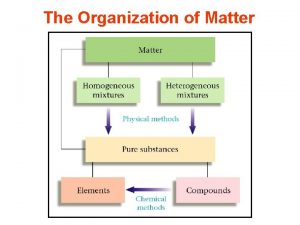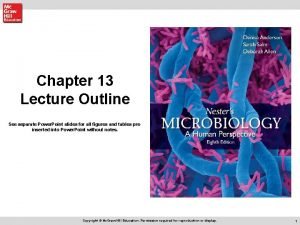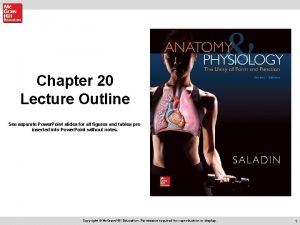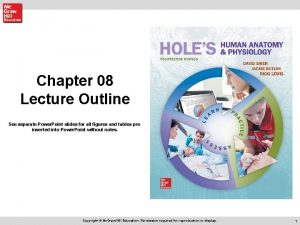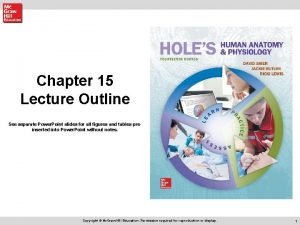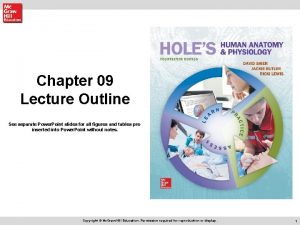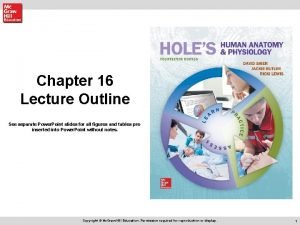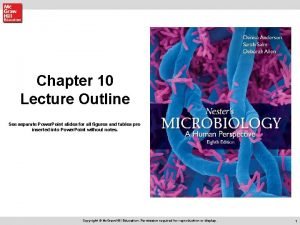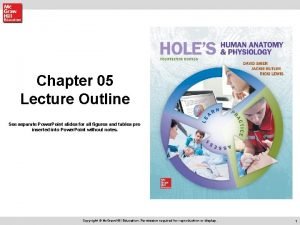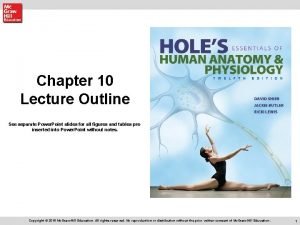Chapter 19 Lecture Outline See separate Power Point




































- Slides: 36

Chapter 19 Lecture Outline See separate Power. Point slides for all figures and tables preinserted into Power. Point without notes. Copyright © Mc. Graw-Hill Education. Permission required for reproduction or display. 1

A Glimpse of History § Puerperal fever: bacterial infection of uterus • By mid 19 th century, one out of eight women died in Vienna hospitals following childbirth • Ignaz Semmelweis observed puerperal fever • Incidence in one section (run by medical students) was four times second section (run by midwives and midwifery students) • A friend sustained scalpel wound during an autopsy, died of symptoms similar to puerperal fever • Semmelweis reasoned “poison” that killed his friend was transferred to women in childbirth by medical students – Before Pasteur, Koch: germ theory of disease – “Poison” was probably Streptococcus pyogenes • washing hands with strong disinfectant: incidence of puerperal fever dropped to one-third previous level

Epidemiology § Epidemiology is study of distributions and causes of disease in populations • Epidemiologists collect, compile data about sources of disease and risk factors • Design infection control strategies, prevent or predict spread of disease • Expertise in many disciplines including ecology, microbiology, sociology, statistics, and psychology • Many of our daily habits (handwashing, waste disposal) based on epidemiology

19. 1. Basic Concepts of Epidemiology § Communicable (contagious) diseases • Transmitted from one host to another • For example, measles, colds, influenza • Transmission determined by interactions between environment, pathogen, and host • Control of any of these factors may break infection cycle – For example, improved sanitation (prevent infection); antimicrobial medications (kill or inhibit pathogens); vaccination (increase host resistance) § Non-communicable diseases • Do not spread from host to host • Microorganisms most often arise from individual’s normal microbiota or environment (for example, Legionella pneumophila in water systems of buildings)

19. 1. Basic Concepts of Epidemiology § Rates of Disease in a Population • Epidemiologists more concerned with rate than absolute number of cases (consider small vs. large city) • Attack rate is percentage of people who become ill in population after exposure • Reflects infectious dose, immune status of population • Incidence rate is number of new cases/time/population • Measure of risk of an individual contracting a disease • Prevalence is total number of cases at any time or for a specific period in a given population • Reflects overall impact of disease on society; includes old and new cases, as well as duration of disease • Both expressed as cases per 100, 000 people

19. 1. Basic Concepts of Epidemiology § Rates of Disease in a Population (continued…) • Morbidity is incidence of disease in a defined population • Contagious diseases (for example, influenza) often have high morbidity rate: infected individual may transmit to several • Mortality is overall death rate in population • Case-fatality rate is percentage of population that dies from a specific disease • Ebola feared because of very high rate

19. 1. Basic Concepts of Epidemiology § Rates of Disease in a Population (continued…) • Endemic diseases constantly present in population • For example, common cold in United States • Sporadic few cases from time to time • Epidemic is unusually large number of cases • Can be from introduced or endemic disease • Outbreak is group of cases at specific time and population • Pandemic is global • For example, AIDS

19. 2. Chain of Infection

19. 2. Chain of Infection § Reservoirs of Infection • Natural habitat in which pathogen lives • In or on animal, human, or in environment (soil, water) • Identification important in disease control – For example, control of rats, mice, prairie dogs (reservoirs of Yersinia pestis) prevents plague epidemics in U. S. • Human Reservoirs • Only in humans or exist in other animals, environment • Often easier to control if only in humans – For example, smallpox • Symptomatic or asymptomatic

19. 2. Chain of Infection § Reservoirs of Infection (continued…) • Human Reservoirs • Symptomatic infections: obvious source of pathogens • Asymptomatic infections: harder to identify, carriers may not realize, can spread to others – Up to 50% of women infected with Neisseria gonorrhoeae are asymptomatic, easily transmit – Many people carry Staphylococcus aureus • Non-Human Animal Reservoirs • Common (gastrointestinal pathogens, rabies virus) • Zoonoses (zoonotic diseases) exist in mostly in animals, can be transmitted to humans (examples, plague, rabies) • More severe in humans • Environmental Reservoirs • Difficult or impossible to eliminate (Clostridium)

19. 2. Chain of Infection § Portals of Exit and Portals of Entry • Body surface or orifice: entry, exit route for pathogen • Intestinal tract: shed in feces (example, Vibrio cholerae) • Respiratory tract: exit in droplets of saliva, mucus (example, Mycobacterium tuberculosis, respiratory viruses) • Skin: shed on skin cells (example, Staphylococcus aureus) • Genital pathogens: semen, vaginal secretions (example, Neisseria gonorrhoeae) • To cause disease, must be transmitted, also colonize surface or enter host

19. 1. Principles of Epidemiology § Disease Transmission • Vertical transmission is pregnant woman to fetus or mother to infant during childbirth, breast feeding • Horizontal transmission is person to person via air, physical contact, ingestion of food or water, or vector

19. 2. Chain of Infection § Disease Transmission (continued…) • Direct Contact: handshake, sexual intercourse • Infectious dose important (for example, for Shigella is 10– 100 cells) • From hands, can be ingested: fecal-oral transmission • Handwashing considered single most important measure for preventing spread of infectious disease • Some pathogens cannot survive in environment, require intimate sexual contact (Treponema pallidum, Neisseria gonorrhoeae) • Droplet Transmission: respiratory droplets generally fall to ground within a meter from release • Densely populated buildings (schools, military barracks) • Spread minimized by covering mouth when sneezing

19. 2. Chain of Infection § Disease Transmission (continued…) • Indirect Contact • Air: respiratory diseases commonly transmitted • Particles larger than 10 µm usually trapped by mucus • Smaller particles can enter lungs, carry pathogens • Talking, laughing, singing, sneezing, coughing generate – Droplet nuclei (microbes attached to dried material) remain suspended • Number of bacteria in air proportional to number of people • Difficult to control • Ventilation systems, negative pressure, HEPA filters

19. 2. Chain of Infection § Disease Transmission: Vehicle-borne § Fomites: inanimate objects • Clothing, table-tops, doorknobs, drinking glasses • Food and Water: can become contaminated • Animal products (meat, eggs) from animal’s intestines • Cross-contamination: transfer from one food to another • Municipal water systems can distribute to large numbers – For example, Cryptosporidium parvum outbreak in Milwaukee, Wisconsin (1993)

19. 2. Chain of Infection § Disease Transmission: Vector-borne • Vectors: living organisms that can carry pathogen • Most commonly arthropods: mosquitoes, flies, fleas, lice, ticks; can carry internally or externally • Can be mechanical or biological • Vector control important in preventing diseases

19. 3. Factors That Influence the Epidemiology of Disease § Characteristics of the Pathogen • Virulence: ability to cause disease • Factors that allow pathogen to adhere to or penetrate host cell, thwart immune defenses, damage host

19. 3. Factors That Influence the Epidemiology of Disease § Characteristics of the Pathogen (continued…) • The Dose: minimum number of pathogens required • Doses below minimum necessary may produce asymptomatic infection: immune system eliminates organism before symptoms appear • Very large dose (example, laboratory accident) may produce serious disease even in normally immune individual • The Incubation Period: influences extent of spread • Long incubation period can allow extensive spread – 10, 000 individuals drank water containing Salmonella enterica serotype Typhi; 10– 14 day incubation allowed spread of typhoid fever to at least 6 different countries (1963; ski resort in Switzerland)

19. 3. Factors That Influence the Epidemiology of Disease § Characteristics of the Host • Immunity to Pathogen: previous exposure, immunization • Herd immunity protects non-immune individuals in population; >90% immunity typically sufficient • Antigenic variation can overcome (for example, avian influenza) • General Health: malnutrition, overcrowding, fatigue • Developing world more susceptible: crowding, poor food, sanitation • Age: very young, elderly generally more susceptible • Immune system less developed in young; wanes in old • Elderly also less likely to update immunizations

19. 3. Factors That Influence the Epidemiology of Disease § Characteristics of the Host (continued…) • Gender: • Women more likely to develop urinary tract infections – Urethra is shorter; microbes more likely to ascend – Pregnant women more susceptible to listeriosis • Religious and Cultural Practices: • Breastfeeding provides protective antibodies to infant • Consumption of raw fish can increase exposure (for example, freshwater fish and tapeworm Diphyllobothrium latum) • Genetic Background: • Natural immunity varies widely • Specific receptors may differ (examples, lack of receptor on red blood cell yields immunity to Plasmodium vivax; lack of receptor on white blood cell reduces susceptibility to HIV)

19. 3. Factors That Influence the Epidemiology of Disease § Characteristics of the Environment • Temperature, water and nutrient supply, radiation, and the availability of light and O 2 • Crowding and poor sanitation • Endospores allow survival in damaging conditions • Exposure to antibiotics

19. 4. Epidemiological Studies • John Snow documented 1849– 1854 cholera epidemics in England due to contaminated water supplies • Demonstrated importance of epidemiologic studies long before relationship between microbes, disease accepted • Descriptive Studies: data collected following outbreaks • The Person: age, gender, ethnicity, occupation, personal habits, previous illnesses, socioeconomic class, marital status may all yield clues about risk • The Place: geographic location helps pinpoint source, yield clues about potential reservoirs, vectors, or boundaries that might affect transmission

19. 4. Epidemiological Studies • Descriptive Studies (continued…) • The Time: season important; also rate of spread – Propagated epidemic: slow rise in cases suggests contagious disease spreading in population; first case is called index case – Common-source epidemic: rapid rise in cases suggests exposure to single source of pathogen

19. 4. Epidemiological Studies § Analytical Studies • Determine relevancy of risk factors • Case-control study attempts to identify causative chain of events leading to disease • Cross-Sectional Studies: surveys range of people – May suggest associations between risk factors, disease • Cohort studies with known exposure to risk factor are selected and followed over time

19. 4. Epidemiological Studies § Experimental Studies • Judge cause/effect relationship of risk (or preventative) factors and development of disease • Treatment compared with known treatment or placebo • Double-blind studies conducted to avoid bias

19. 5. Infectious Disease Surveillance § National Disease Surveillance Network • Centers for Disease Control and Prevention publishes Morbidity and Mortality Weekly Report (MMWR)

19. 5. Infectious Disease Surveillance § National Disease Surveillance Network (cont…) • Public Health Departments in each state • Have authority to mandate diseases that must be reported • Washington State health authorities responded rapidly to Escherichia coli O 157: H 7 outbreak in 1993 – One of few states with surveillance and reporting for E. coli O 157: H 7; epidemic had started in other states • Fungus Cryptococcus gattii first appeared in WA in 2007, causes lung infections, meningitis; OR, CA now monitor • Other components of the Public Health Network • Public schools report absentee rates • Hospital laboratories report on isolation of pathogens with epidemiological significance • News media alert public to presence of infectious diseases

19. 5. Infectious Disease Surveillance § Worldwide Disease Surveillance • World Health Organization (WHO) has four main functions – Provide worldwide guidance in field of health – Set global standards for health – Cooperatively strengthen national health programs – Develop and transfer appropriate health technology • WHO provides education, technical assistance • Disseminates information via periodicals, books – For example, Weekly Epidemiological Record

19. 5. Infectious Disease Surveillance § Reduction and Eradication of Disease • Many diseases reduced through improved sanitation, reservoir and vector control, vaccination, and antibiotic treatment; smallpox has been eradicated globally – In U. S. , many formerly common diseases rare – Work underway to eradicate measles, polio, dracunculiasis • New pathogens emerging • Resurgence of infectious diseases

19. 6. Emerging Infectious Diseases § Include new or newly recognized Middle East respiratory syndrome (MERS), mad cow disease, avian flu; also reemerging malaria and tuberculosis • Many factors contribute to emergence and reemergence • Microbial evolution: example, Vibrio cholerae O 139 gained ability to produce capsule; antibiotic resistance • Complacency and public health efforts: successes can divert attention: example, tuberculosis • Changes in human society: example, day care centers relatively new in U. S. allow easy transfer of pathogens

19. 6. Emerging Infectious Diseases § Many factors contribute to emergence and reemergence • Advances in technology: example, contact lenses • Population expansion: increased contact with reservoirs of disease: Ebola virus, Lyme disease • Development: example, dams extending range of schistosomiasis by increasing habitat for host snail • Mass production, widespread distribution, and importation of food: foodborne illnesses easily spread • War and civil unrest: disruption of infrastructure and eradication efforts, refugee camps with poor conditions • Climate changes: warm temperatures favor reproduction of some arthropods that serve as vectors; heavy flooding from El Niño may have increased cholera cases in Africa

19. 7. Healthcare-Associated Infections § Healthcare-associated infections (HAIs) • Acquired while receiving treatment in healthcare setting • One of top 10 causes of death in United States • Hospital-acquired nosocomial infections problematic throughout history: hospitals are densely populated with unusually susceptible people, where resistant and virulent pathogens may exist • Estimated 5– 10% of patients admitted in U. S. acquire – About 2/3 are from patients’ own normal microbiota

19. 5. Healthcare-Associated Infections

19. 7. Healthcare-Associated Infections § Reservoirs of Infectious Agents in Healthcare Settings • Other Patients: pathogens discharged via skin cells, respiratory droplets, other bodily secretions and excretions • Healthcare Environment: some Gram-negative rods can thrive in sinks, respirators, toilets – Pseudomonas aeruginosa resistant to many disinfectants, antimicrobials; requires few nutrients – Many nosocomial infections traced to contaminated soaps, disinfectants, other aqueous solutions • Healthcare Workers: sick workers, carriers of pathogens (examples, Staphylococcus aureus, Streptococcus pyogenes) • Patient Microbiota: invasive procedures can transmit normal microbiota to sterile body sites; compromised immune system may allow infection to develop

19. 7. Healthcare-Associated Infections § Transmission of Infectious Agents in Healthcare Settings • Direct Transmission—Healthcare Personnel – Must be extremely vigilant with handwashing, disinfecting, wearing gloves • Fomite Transmission—Medical Devices – Often breach first-line barriers of defense catheters, IV, mechanical respirators, inadequately sterilized invasive instruments • Airborne Transmission – Reduce with air pressure, careful mopping, HEPA filters

19. 7. Healthcare-Associated Infections § Preventing Healthcare-Associated Infections • Important to detect, establish appropriate policies to stop • Hospitals have Infection Control Committee; implement policies based on Standard Precautions and the Transmission-Based Precautions – Includes guidelines on hand hygiene, personal protective equipment, respiratory hygiene/cough etiquette, patient placement, patient-care equipment and instruments/devices, care of the environment, textiles and laundry, safe injection practices, infection control practices for special lumbar puncture procedures, and worker safety • CDC has established Healthcare Infection Control Practices Advisory Committee (HICPAC)
 Essay writing c
Essay writing c 01:640:244 lecture notes - lecture 15: plat, idah, farad
01:640:244 lecture notes - lecture 15: plat, idah, farad Real power formula
Real power formula Power bi training powerpoint
Power bi training powerpoint Point point power
Point point power Lecture outline example
Lecture outline example Lecture outline example
Lecture outline example Lecture outline example
Lecture outline example Lecture outline meaning
Lecture outline meaning Sentence outline example
Sentence outline example A separate peace chapter 1
A separate peace chapter 1 Chapter 8 separate financial statements
Chapter 8 separate financial statements Power system dynamics and stability lecture notes
Power system dynamics and stability lecture notes Power system analysis lecture notes
Power system analysis lecture notes Power semiconductor devices lecture notes
Power semiconductor devices lecture notes Switch mode power supply lecture notes
Switch mode power supply lecture notes Power system dynamics and stability lecture notes
Power system dynamics and stability lecture notes Traditions in things fall apart
Traditions in things fall apart 5 paragraph essay format
5 paragraph essay format Human resources department structure
Human resources department structure Human resources management chapter 1
Human resources management chapter 1 Human resource management lecture chapter 1
Human resource management lecture chapter 1 What is an introductory clause
What is an introductory clause Separate result unknown
Separate result unknown Filtration of sand and salt
Filtration of sand and salt How to separate raisins and flour
How to separate raisins and flour How to separate salt and water
How to separate salt and water Cleanse the palate after a rich dinner and before dessert
Cleanse the palate after a rich dinner and before dessert Fungsi guest bill adalah
Fungsi guest bill adalah Separate result unknown
Separate result unknown What is the invisible line that runs from north to south
What is the invisible line that runs from north to south Chet douglass a separate peace
Chet douglass a separate peace Re-hashing
Re-hashing Separate chaining
Separate chaining Are english literature and language separate gcses
Are english literature and language separate gcses Living things grow images
Living things grow images A coordinate adjective is
A coordinate adjective is
























